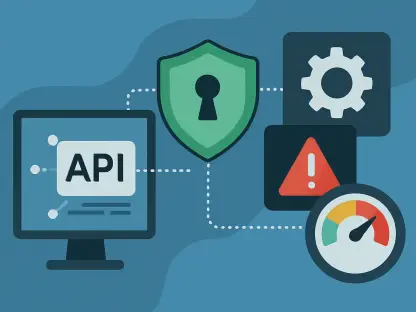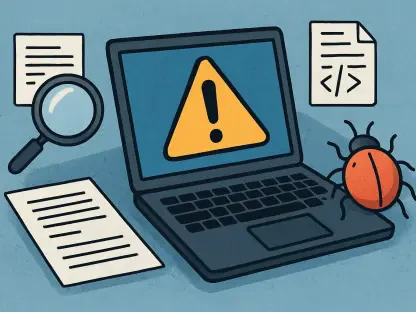In an era where connectivity is paramount, a disturbing trend has emerged in the cybersecurity landscape, revealing how seemingly innocuous devices like cellular routers can become powerful weapons in the hands of malicious actors. These devices, often used to provide internet access in remote or mobile environments, are being hijacked through their web-based management interfaces to orchestrate large-scale SMS attacks. Hackers are exploiting exposed APIs to send malicious text messages that deceive users into clicking harmful links, leading to phishing scams or malware infections. This alarming tactic not only bypasses traditional security measures but also exploits the inherent trust people place in SMS communications, making it a stealthy and effective method for cybercriminals to target unsuspecting victims.
Unveiling the Mechanics of the Threat
API Vulnerabilities as Entry Points
The core of this cyber threat lies in the exploitation of vulnerabilities within the APIs of cellular routers, which are often left exposed due to inadequate security configurations. Hackers systematically scan the internet for routers with accessible vendor APIs, particularly those utilizing protocols like TR-064 or custom HTTP-based interfaces for SMS functionality. Once identified, gaining access is often a trivial matter due to default or weak administrative credentials that many users fail to change. After breaching these systems, attackers can issue commands to send arbitrary SMS messages using the router’s embedded SIM card. These messages frequently pose as urgent alerts or legitimate notifications, tricking recipients into engaging with malicious content. The absence of robust input validation in many of these APIs allows attackers to embed harmful links or scripts without restriction, turning a trusted device into a conduit for mass phishing campaigns.
Automation and Sophistication in Attack Execution
Beyond simply gaining access, the sophistication of these attacks is evident in the automation tools and tactics employed by hackers to maximize their impact. Scripts are often used to cycle through extensive lists of phone numbers, randomize sender IDs to avoid suspicion, and dynamically update malicious URLs through public paste sites to evade detection by security software. Furthermore, feedback from SMS API status codes and delivery reports enables attackers to refine their campaigns in real-time, identifying which messages successfully reach targets and adjusting their approach accordingly. This level of operational efficiency highlights a significant gap in current cybersecurity practices, as many network administrators do not routinely monitor SMS traffic with the same vigilance applied to other data streams. As a result, these campaigns can persist undetected for extended periods, amplifying the potential damage to both individuals and organizations.
Addressing the Scale and Impact of the Issue
Widespread Reach and Escalating Consequences
The scale of this emerging threat is staggering, with security operations centers noting a marked increase in unusual SMS traffic originating from both residential and enterprise routers in recent months. These attacks are not merely opportunistic but are evolving into highly targeted campaigns as attackers refine their tactics. Initially, generic lures are deployed, but over time, hackers leverage harvested data to craft personalized messages that significantly boost click-through rates. The consequences extend far beyond immediate risks like credential theft; successful exploits can install backdoors for persistent access, facilitate lateral movement within corporate networks, and even transform compromised routers into additional SMS-spam bots. This cascading effect underscores the urgent need to recognize routers not as peripheral devices but as critical components of network security that require stringent protection.
Systemic Security Flaws and Industry Challenges
Compounding the problem is the systemic nature of the vulnerabilities across a diverse range of router models and manufacturers, pointing to broader issues in device security standards. Many of these devices ship with unchanged default credentials and outdated firmware that lacks essential safeguards like rate-limiting or strong authentication mechanisms for SMS interfaces. This oversight is exacerbated by the general perception that routers are low-priority targets, often leading to neglect in terms of regular updates or monitoring for unusual activity. The trust users place in SMS as a secure communication channel further amplifies the effectiveness of these attacks, as recipients are less likely to question the legitimacy of messages appearing to come from trusted sources. Addressing this challenge requires a fundamental shift in how the industry approaches the security of IoT and network devices, especially as their integration into critical infrastructure continues to grow.
Strategies for Mitigation and Future Defense
Immediate Protective Measures for Network Security
In response to this growing threat, immediate steps must be taken to secure cellular routers and disrupt the ability of attackers to exploit their APIs for malicious SMS campaigns. Enforcing strong, unique administrative credentials is a critical first step, alongside disabling unused SMS interfaces to minimize exposure. Applying firmware updates promptly ensures that devices benefit from the latest security patches, including those that implement proper authentication and rate-limiting controls to prevent abuse. Additionally, proactive monitoring of SMS traffic for anomalies can help detect and halt campaigns before they escalate. These measures, while straightforward, require consistent implementation across both individual and enterprise environments to effectively reduce the window of opportunity for attackers and safeguard users from falling victim to sophisticated social engineering tactics embedded in malicious messages.
Long-Term Industry Focus on Device Security
Looking ahead, the industry must prioritize a more comprehensive approach to securing network equipment, recognizing the evolving tactics of threat actors who continue to exploit overlooked vulnerabilities. Reflecting on past efforts, it became evident that collaboration between manufacturers, cybersecurity experts, and end-users has been essential in raising awareness about the risks posed by unsecured routers. Initiatives taken previously to standardize security protocols proved effective in mitigating similar threats, and those lessons guided subsequent actions. By fostering greater attention to robust design practices and regular security audits, stakeholders managed to address systemic flaws that once left devices exposed. The focus then shifted toward educating users on best practices and ensuring that the integration of IoT devices into critical systems no longer represented a weak link in the cybersecurity chain, ultimately strengthening defenses against innovative attacks.









